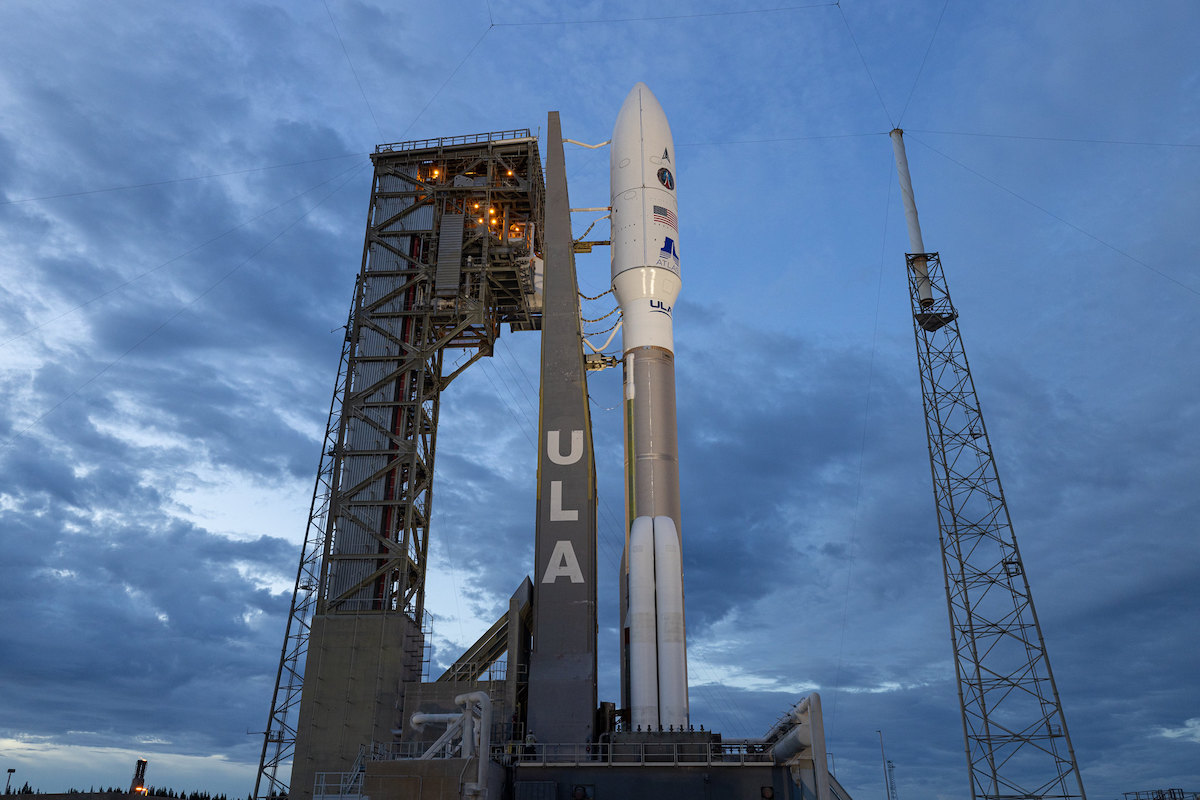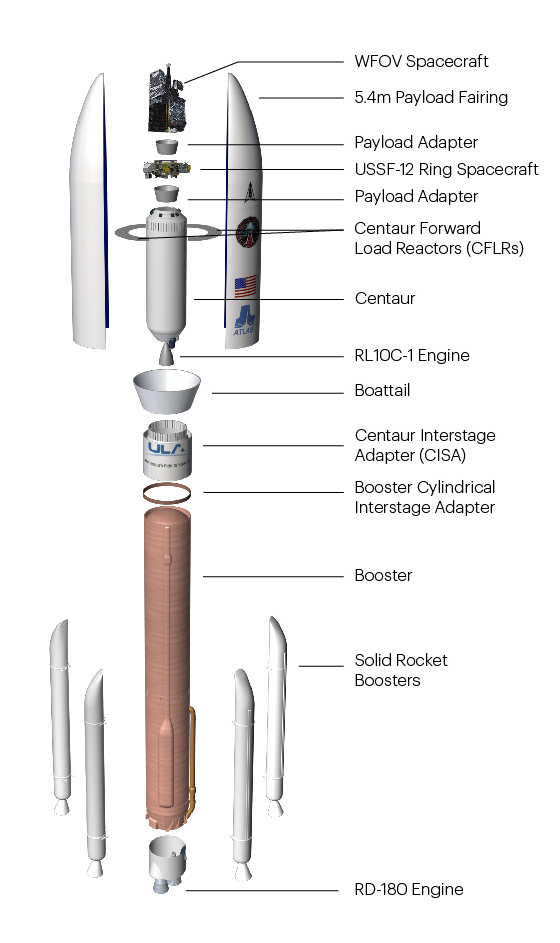Live coverage of the countdown and launch of a United Launch Alliance Atlas 5 rocket from pad 41 at Cape Canaveral Space Force Station in Florida. The mission, known as USSF 12, will launch the U.S. Space Force’s Wide Field of View Testbed satellite and the USSF 12 Ring spacecraft into geosynchronous orbit. Text updates will appear automatically below. Follow us on Twitter.
SFN Live
A United Launch Alliance Atlas 5 rocket is ready to boost two experimental U.S. Space Force satellites all the way to geosynchronous orbit in a six-hour mission launching from Cape Canaveral Thursday. The two-hour launch window opens at 6 p.m. EDT (2200 GMT).
There is a 40% chance of favorable weather at the opening of the window Thursday in the official launch forecast issued by the Space Force’s 45th Weather Squadron. The forecast improves later in the window, when there’s a 60% chance of favorable conditions for launch.
The mission, codenamed USSF 12, will be the fourth Atlas 5 flight of the year, and the 94th launch of an Atlas 5 rocket overall. It is one of 23 Atlas 5s remaining in ULA’s inventory before the rocket is retired. ULA, a 50-50 joint venture between Boeing and Lockheed Martin, is developing the next-generation Vulcan Centaur rocket to replace the Atlas and Delta rocket families.
One of the payloads on the mission is the Space Force’s Wide Field Of View, or WFOV, Testbed satellite to demonstrate a new infrared sensor capable of detecting and tracking missile launches, providing early warning of a potential attack on the United States of allied nations.
The WFOV spacecraft will ride to space in the upper portion of the Atlas 5 rocket’s payload compartment. A secondary payload, called the USSF 12 Ring, is positioned below the WFOV spacecraft for launch. It hosts multiple payloads, experiments and prototypes, but details about their missions are classified.
A Space Force spokesperson told Spaceflight Now the entire USSF 12 mission, including the payloads and launch services, cost about $1.1 billion.

The countdown for the launch Thursday began at 10:40 a.m. EDT (1440 GMT). ULA teams planned to turn on the Atlas 5 flight computer, complete checks of the rocket’s guidance system, and then configure the vehicle for the start of cryogenic tanking around 4 p.m. EDT (2000 GMT).
Nearly 66,000 gallons of liquid hydrogen and liquid oxygen will be loaded into the two-stage Atlas 5 rocket. The Centaur upper stage’s Aerojet Rocketdyne RL10 engine burns the hydrogen and oxygen propellant mix, and the Atlas first stage consumes liquid oxygen with 25,000 gallons room-temperature kerosene fuel, which was loaded into the rocket Wednesday, soon after ULA ground crews rolled the Atlas 5 the launch pad from the nearby Vertical Integration Facility.
Two built-in holds are planned in the countdown, one at T-minus 2 hours and another at T-minus 4 minutes, before the final four-minute terminal countdown sequence to prepare the Atlas 5 rocket liftoff.
The rocket’s propellant tanks will be pressurized, and the RD-180 engine will ignite at T-minus 1 second. After building up thrust on the main engine, the Atlas 5 will send the command to light four Northrop Grumman strap-on solid rocket boosters to power the launcher off pad 41 with 2.3 million pounds of thrust.
The version of the Atlas 5 launching on the USSF 12 mission is known as the “541” configuration, with the first number denoting the size of the payload fairing, the second number representing the number of solid rocket booster, and the third digit the number of engines on the Centaur stage.
The 196-foot-tall (59.7-meter) Atlas 5 rocket, designated AV-094 for this mission, will head east from Cape Canaveral to target the mission’s equatorial orbit more than 22,000 miles (nearly 36,000 kilometers) above Earth.
The Atlas 5 will surpass the speed of sound in 58 seconds, then shed its spent strap-on boosters at T+plus 1 minute, 48 seconds. The 5.4-meter-wide (17.7-foot) composite payload shroud will jettison at T+plus 3 minutes, 25 seconds, and the Russian-made RD-180 core stage engine will fire until T+plus 4 minutes, 24 seconds.

The USSF 12 mission marks the 100th flight of an RD-180 engine since it first launched in May 2000 on an Atlas 3 rocket.
After separation of the Atlas first stage, ULA’s Centaur upper stage will take over the flight with three burns of its single RL10 engine to first place the two Space Force payloads into a parking orbit, then propel the mission into higher orbits and on a trajectory hugging the equator.
The WFOV Testbed spacecraft, built by Millennium Space Systems, will separate from the Centaur upper stage at T+plus 5 hours, 49 minutes. An adapter structure will release about 10 minutes later, revealing the Northrop Grumman-built USSF 12 Ring payload for separation at T+plus 6 hours, 5 minutes.
ROCKET: Atlas 5 (AV-094)
MISSION: USSF 12
PAYLOAD: WFOV Testbed and USSF 12 Ring
LAUNCH SITE: SLC-41, Cape Canaveral Space Force Station, Florida
LAUNCH DATE: June 30 , 2022
LAUNCH WINDOW: 6:00-8:00 p.m. EDT (2200-0000 GMT)
WEATHER FORECAST: 60% chance of acceptable weather
BOOSTER RECOVERY: None
LAUNCH AZIMUTH: East
TARGET ORBIT: Approximately 22,440 miles, 0.0 degrees inclination
LAUNCH TIMELINE:
- T-00:00:01.0: RD-180 ignition
- T+00:00:01.0: Liftoff
- T+00:00:06.9: Begin pitch/yaw maneuver
- T+00:00:57.8: Mach 1
- T+00:01:07.4: Maximum aerodynamic pressure (Max-Q)
- T+00:01:48.4: Solid rocket booster jettison
- T+00:03:25.6: Payload fairing jettison
- T+00:04:24.3: Atlas booster engine cutoff (BECO)
- T+00:04:30.3: Atlas/Centaur stage separation
- T+00:04:40.2: Centaur first main engine start (MES-1)
- T+00:10:58.2: Centaur first main engine cutoff (MECO-1)
- T+00:23:13.6: Centaur second main engine start (MES-2)
- T+00:28:41.9: Centaur second main engine cutoff (MECO-2)
- T+05:43:54.1: Centaur third main engine start (MES-3)
- T+05:46:20.0: Centaur third main engine cutoff (MECO-3)
- T+05:49:36.0: WFOV Testbed spacecraft separation
- T+05:59:03.9: Booster adapter separation
- T+06:05:21.0: USSF 12 Ring spacecraft separation
MISSION STATS:
- 676th launch for Atlas program since 1957
- 377th Atlas launch from Cape Canaveral
- 265th mission of a Centaur upper stage
- 242nd use of Centaur by an Atlas rocket
- 512th production RL10 engine to be launched
- 40th RL10C-1 engine launched
- 100th flight of an RD-180 main engine
- 94th launch of an Atlas 5 since 2002
- 36th U.S. Air Force/Space Force use of an Atlas 5
- 14th-17th GEM-63 solid rocket boosters flown
- 78th launch of an Atlas 5 from Cape Canaveral
- 4th Atlas 5 launch of 2022
- 136th Evolved Expendable Launch Vehicle flight
- 151st United Launch Alliance flight overall
- 86th Atlas 5 under United Launch Alliance
- 109th United Launch Alliance flight from Cape Canaveral
- 35th 500-series flight of the Atlas 5
- 9th Atlas 5 to fly in the 541 configuration
- 105th launch from Complex 41
- 78th Atlas 5 to use Complex 41
- 28th orbital launch overall from Cape Canaveral in 2022